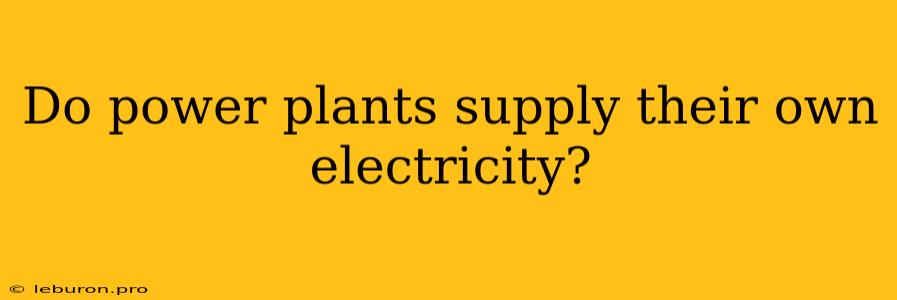Power plants, the massive structures that generate the electricity powering our homes, businesses, and industries, are often perceived as self-sufficient entities. After all, they are the source of electricity, so it seems logical that they would be able to power themselves. However, the question of whether power plants supply their own electricity is a bit more nuanced than that. While they certainly generate electricity, the specific way they utilize it internally can be quite complex and depends on various factors like the type of power plant and its design. This article delves into the intricacies of how power plants manage their energy requirements, examining the different approaches employed and exploring the concept of "house load" – the electricity used by the plant itself.
The Complexities of Power Plant Energy Management
The concept of power plants supplying their own electricity necessitates understanding the different types of power plants and their operational processes. Power plants can be broadly categorized into:
1. Thermal Power Plants:
These plants generate electricity using heat energy from burning fuels like coal, natural gas, or oil. The process involves:
- Fuel Combustion: Burning the fuel generates heat, which is used to create steam.
- Steam Turbine: The steam drives a turbine, which rotates a generator.
- Electricity Generation: The generator converts mechanical energy into electrical energy.
In thermal power plants, a significant portion of the electricity generated is used to power the plant's internal systems. This includes:
- Auxiliary Equipment: This encompasses pumps, fans, and other machinery essential for plant operations.
- Cooling Systems: Keeping the plant cool is crucial, particularly for steam turbines and generators.
- Control Systems: Monitoring and controlling the various aspects of the power plant operation.
Therefore, thermal power plants do not directly "supply their own electricity" in the sense that all the generated electricity is consumed by the plant itself. Instead, a portion of the electricity produced is used to power the internal systems, while the rest is transmitted to the grid for external use.
2. Nuclear Power Plants:
Nuclear power plants utilize nuclear fission to generate heat, which is then converted into electricity using the same principles as thermal power plants. However, the process involves a more complex chain of events and specialized equipment, including a nuclear reactor, a steam generator, and a turbine generator.
Nuclear power plants, like their thermal counterparts, require a substantial amount of electricity to operate their internal systems. This includes powering the control systems, cooling systems, and the pumps that circulate the reactor coolant.
Therefore, nuclear power plants also do not directly "supply their own electricity". They generate a significant amount of electricity, but a considerable portion is used for internal operations, with the remaining electricity being fed into the grid.
3. Renewable Energy Power Plants:
Renewable energy sources like solar, wind, and hydro power have their own unique characteristics and power generation processes.
- Solar Power Plants: These plants use photovoltaic cells to convert sunlight into electricity.
- Wind Power Plants: Wind turbines harness the kinetic energy of wind to generate electricity.
- Hydroelectric Power Plants: Dams and water turbines convert the potential energy of stored water into electricity.
Renewable energy power plants often require less "house load" (electricity used internally) compared to thermal or nuclear plants. This is because many of their components, like solar panels or wind turbines, are relatively simple and require less energy for operation.
However, even renewable energy power plants need some electricity for their internal functions. This includes powering the control systems, monitoring equipment, and the grid connection systems.
"House Load" in Power Plants:
The electricity used by a power plant to power its internal systems is referred to as "house load." This "house load" can vary significantly depending on factors like:
- Plant Size and Design: Larger power plants typically have a higher house load due to their more complex systems.
- Operating Efficiency: Efficiently designed plants can minimize their internal energy requirements.
- Type of Power Plant: Nuclear and thermal power plants generally have higher house loads than renewable energy power plants.
The "house load" is a crucial factor in the overall efficiency of a power plant. A high house load reduces the amount of electricity available for external use, ultimately affecting the plant's economic viability.
Conclusion:
The question of whether power plants supply their own electricity is a complex one. While they do generate electricity, a significant portion of that electricity is used to power the plant's internal systems. This "house load" is essential for maintaining operations but also affects the plant's overall efficiency. It's important to remember that power plants are not designed to be completely self-sufficient in terms of electricity; they are designed to generate and distribute electricity to a larger network. Understanding the intricacies of "house load" and how power plants manage their energy requirements provides a deeper understanding of their complex role in our modern energy systems.
